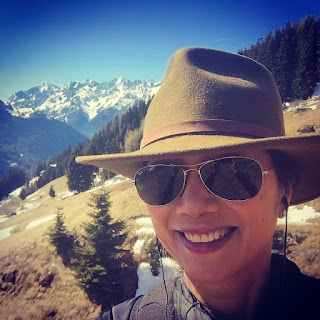My Thoughts On Training.....
Training in Verbier
With Kunjan, my Nepalese trainer, doing strength training.
A lot has been written about the best way to train for the trek to Everest Base Camp and Kala Patthar. Some say that you need to train months in advance, hitting the running machine at a high incline with a heavy backpack, hiring a trainer for strength training, walking and using the stairs rather than taking a car or elevator. But I believe the best way to train for a trek is hiking the hills in altitude and doing some strength training in the gym to supplement that. You cannot control how you react to high altitude (it can be life threatening with pulmonary or cerebral edema) or if you have intestinal issues (almost unavoidable) but you can manage your fitness.
Petra
I have always enjoyed exercise and sport but my interest in trekking only began with my trek from the Dead Sea to Petra 7 years ago. I got involved in that charity walk primarily because of the hopeless romanticism I attached to the desert (Lawrence of Arabia, English Patient plus Indiana Jones) and the trek was for a good cause. I used to be the sort of person that took the car to my destinations two minutes away and going to the great outdoors for fun was limited to the ski and beach holidays. Before this Jordanian trek, hiking was my idea of slow death outdoors and very dull so I never ventured outside except to have a cigarette!
We walked across the Jordanian desert over 5 days.
After the desert trek, I realised that walking was enjoyable, quite relaxing and a wonderful way to see the world. It was also a sport that I could do even if I had numerous knee operations (two ACL reconstructions, shattered menisci or knee cartilage), suffered broken bones (arm, leg, shoulder, hand, ribs) with some resulting in painful arthritis, and an old nagging herniated disc problem in my lower back. A good knee brace for long continuous days of steep downhills, ibuprofen (for knee swelling) Imodium (for tummy issues) and diamox (for altitude) was all I have ever needed medically for these treks. The old skiing injuries somehow never really bothered me as much as the odd blister.
The same can be said about training for trekking. It can appear eye-wateringly dull, hiking up and down paths but I will admit to enjoying it. Every day I try to find a new path, then go for longer periods, higher elevation, adding gradient as the days go by. I try and increase difficulty gradually and never to the point of panic. I stop and look at the scenery, take photos, listen to podcasts and books, and feel lucky that I can go back and eat as much as I want! Also, with my guide Cherries (google Cherries Walks), we explore more challenging routes she is familiar with, while helping me build up my endurance.
Views in Verbier from my daily walk.
Hiking with Cherries
Trekking for me now is an exercise in discovery, and that enjoyment has resulted in my various adventures. In the last few years I have seen Petra, the Dead Sea, Machu Picchu, various parts of Spain en route to Santiago, the Atlas Mountains in Morocco, London at dawn whilst doing the moonwalk/marathon, the hills of Cornwall, the Kii Peninsula in Japan and so forth and so on. And unlike being in a car or a train, I've had the time to breathe in my surroundings, take photos, and really enjoy the scenery and local culture.
Sesame noodle lunch in the mountains. Hiking with the family.
Some last words. For me, training for a project like this does not mean abstinence from what makes life fun. I haven't given up bars, dinners, wine, the odd cigarette, and nightclubs. Even if I'm not 100 percent as fit as I should be, I'll take it. I enjoy my life too much!
.
The famous nightclub in Verbier















Comments
Post a Comment